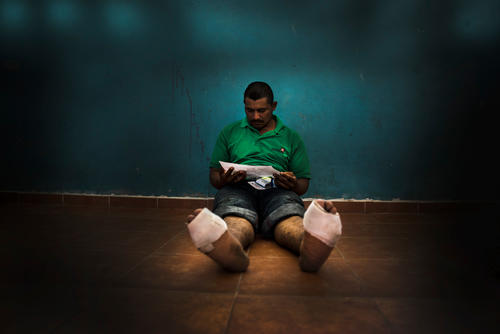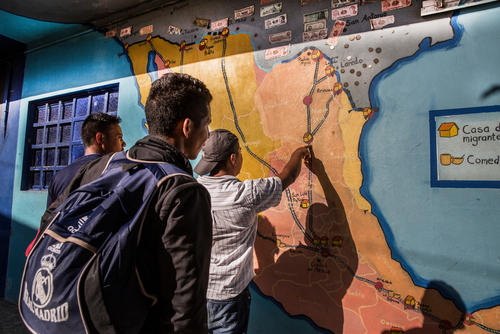In the so-called Northern Triangle of Central America – and along the treacherous migration route north through Mexico to the United States – two powerful opposing forces have trapped thousands of people in a seemingly endless cycle of violence and displacement.
Every year, deep social inequality, political instability and brutal conflict in Guatemala, Honduras and El Salvador drive some 500,000 people to flee northwards in search of safety, while in the US, the government is stepping up deportations and dismantling legal protections for refugees and asylum seekers in an effort to force them back.
Mexico is caught in the middle. Although the US government has repeatedly attempted to declare Mexico a safe place for refugees to seek asylum, evidence – including testimonies collected by Médecins Sans Frontières (MSF) teams working with people on the move across the country – prove that it is anything but. Stranded at waypoints and towns along the border, migrants, refugees and asylum seekers from both Mexico and Northern Triangle countries are exposed to kidnapping, extortion and horrific abuse.
In 2018, we scaled up our response to the physical and psychological consequences of this unfolding disaster, expanding our mental health and psychosocial activities in health facilities as well as migrant shelters along the routes north. We are also working to adapt our response to better serve the growing numbers of people on the move.
No choice but to flee
People treated by MSF teams across the region share stories of the violence and criminality that forced them to leave their homes. In particular, they describe the stranglehold that maras, or gangs, have on people in their home countries. Many see no choice but to flee.
Lucila, a 56-year-old fruit seller from San Salvador, El Salvador’s capital and most populous city, now works in a migrant shelter. She told an MSF psychologist there that her eldest son had been murdered by a gang. When the same gang tried to recruit another one of her children, the two of them left their home for good.
Mother-of-five Guadalupe fled her home in Honduras when one of the maras began to “take an interest” in her 14-year-old son. “The gang wanted him to keep watch for them,” she says. “That’s why we left.” Guadalupe was later attacked and sexually abused at the border between Guatemala and Mexico by two men. She came to the MSF clinic in Tenosique, where we tended her physical and psychological wounds.
MSF teams are running a number of projects in Northern Triangle countries to assist vulnerable and displaced people. In Honduras, our servicio prioritario, or priority service, offers comprehensive emergency medical and psychosocial care to victims of violence, including sexual violence. And in El Salvador, we send mobile clinics to provide primary, mental, and sexual and reproductive health services in regions where insecurity prevents people from accessing medical assistance.

Caring for people on the move
Those who make the heart-wrenching decision to leave their homes encounter more danger on the road. Throughout Mexico, migrants, refugees and asylum seekers face robbery, kidnapping, violence and death. “We see what can be expected in people on the move: sores, dehydration, fever,” says Candy Hernández, an MSF doctor working at Shelter 72 in Tenosique, a Mexican town in Tabasco state on the border with Guatemala. “But we also see the terrible effects of the violence of the gangs that attack [people] on their journeys and then rob them: machete wounds, beatings, abuse and sexual violence.”
Those who push on and make their way through Mexico find that violence and criminality are rife on the US border as well. Kidnapping is a lucrative business here: exhausted and disoriented, many migrants, refugees and asylum seekers are seized by criminal groups at bus stations and then held for ransom.
This is what happened to Alberto, from Guatemala. He ended up in a shelter in Nuevo Laredo, Mexico, where he was seen by our team. “They interrogate you, they take away your mobile phone and they force you to give them your family’s phone number,” he told them. “They call your family and ask for money. It might be US$2,500 or US$3,000.” If a hostage can’t come up with the money, they face torture or death.
From the southern border with Guatemala to the Rio Grande and at key locations in between, we have teams working in fixed and mobile clinics, and in migrant shelters, providing medical and psychosocial support to migrants and refugees, as well as local communities affected by violence. We also offer specialised mental healthcare to victims of extreme violence at a therapeutic centre in Mexico City.
“We see similar situations here for people on the move as we do for people who have lived through war,” explains MSF psychologist Diego Falcón Manzano, who works at the Mexico City facility. Criminals along the migration route often use psychological torture when seeking to extort victims or forcibly recruit new gang members. “Before, on the journey, you were either beaten or raped. Now, they don’t just beat you, they make you see how it’s done to other people. Or they make you kill someone or handle human body parts.”

Forced return
Even if people make it across the border into the US, their problems do not end there: they face the prospect of deportation and being sent back to square one – or worse. And it’s not only the people caught trying to make the crossing who are returned to Mexico or their countries of origin; many others who have spent years or even decades building lives in the US can be suddenly deported to countries they’ve long since stopped calling home.
Deportees find themselves thrust back into the same climate of brutality and fear they tried so desperately to escape. Often, they discover that the gangs they fled have been waiting for their return. Many see no choice but to immediately begin the dangerous journey north once more, re-entering the cycle of violence and displacement, driven by forces outside their control.















